Aside from perennial underachiever England, there may not be another soccer nation that is simultaneously as large and promising, yet consistently underwhelming and disappointing as Mexico. With every decade, no matter how tantalizing they appear to be on paper, the nation’s soccer hopes are inevitably spoiled by malediction, misfortune and mismanagement.
At the highest level of international soccer competition, Mexico somehow squanders its golden opportunities and has failed to advance beyond the fifth game in the World Cup.

Call it bad luck, sure. But it also points to a lack of team cohesion, effective coaching, and, importantly, a composed and transcendent star who can usher in victory in the most crucial moments. However, it appears the current Mexican generation may have finally found their guy — well, it’s actually a kid.
Right now, Gilberto Mora is the most touted Mexican prospect of the modern era. He has already been dubbed by the media as “El Chamaco” (“the kid”), “Morita” (“little Mora”) and “Crackito” (“the little crack,” which is Spanish slang for anyone who is exceptionally great). There’s a reason for all the hype, too.
The 16-year-old made an impact in this year’s Gold Cup tournament when he became the youngest player in FIFA history to win an international senior trophy. His accomplishment surpassed former record holders — Brazilian icon Pele and Spanish wunderkind Lamine Yamal, who both previously were the youngest champions in FIFA history.
Though Mora is certainly not at the level of those global studs quite yet, all signs have indicated that he has a talent and composure at the youth level that El Tri hasn’t known since Carlos Vela and Giovani Dos Santos, who together delivered Mexico its first and only World Cup title by defeating Brazil in the Under-17 category in 2005.
Mexican fans have been enjoying Mora domestically for the past year: He currently stars for Club Tijuana in Liga MX, though there is increasing chatter about the teenager drawing serious attention from the likes of Real Madrid and Barcelona. He is consistent in every game he plays, controlling the tempo, setting up his teammates and scoring when needed — no easy feat for a 16-year-old boy going up against grown, fully developed men.
With his recent success, he is no longer Mexico’s best-kept secret either. Making his debut in Chile this fall — at the U-20 World Cup for male stars under 20 years old — he has suddenly burst onto international soccer’s radar.

In his first two appearances against Brazil and Spain, he assisted and scored twice to keep Mexico afloat in a “Group of Death” that also included Morocco. Mexico would later go on to defeat the group-leading Morocco with — you guessed it — a game-winning goal from Mora himself.
Overall, Mora single-handedly accounted for four of Mexico’s five total goals in the group stage, helping Mexico avoid a single defeat.
His “I’m Him” moment came in the final minutes of Mexico’s clash against Spain. In a must-win situation against the highly ranked Spaniards, the Mexico U-20 team were down 2-1 and all but finished. With less than four minutes of regulation left, Mexico was on the hunt and placed an aerial pass into the box. A Mexican attacker went up and headed the ball awkwardly, but by the grace of the soccer gods, it found the team’s best player: El Crackito.
Mora, who was behind two defenders and his own teammates, one-touched it with his right foot and put it cleanly into the opposite back corner of the net, past the leaping goalkeeper who reacted to the play by falling to the ground on his knees in defeat. In a critical scenario, Mora delivered for his team, and for Mexico.
Like any sports icon in the making, Mora has already faced his fair share of antagonists and disbelievers. Leading up to Mexico’s elimination game against the host nation, Chile, in the Round of 16, Chilean news outlet Desde La Tribuna published an image of Mora’s face overlaid with blackberries being turned into fruit jam by a Chilean player (the definition of “mora” in Spanish is blackberry). The joking caption read: “It’s time to make blackberry jam.”
The headline and image received significant backlash from many soccer fans in both nations, claiming it was in bad taste (no pun intended). Meanwhile, Chile was crushed in a decisive Mexican triumph in which Mora assisted on two of Mexico’s four goals and was then subbed out to conserve the star for Mexico’s following match.
Up to this point, Mexican fans have rejoiced in Mora’s talents with a euphorically comedic and celebratory spin of their own. In the internet age, goofy memes and Tweets have abounded. There’s a video of a child in his underwear impressively dribbling the ball in his living room with the caption: “Me as a 30-year-old pretending to be Gilberto Mora at 3 a.m.”
There’s a GIF of WWE commissioner Vince McMahon vehemently smelling a wad of cash in his hands, with the text reading: “[Club Tijuana owner and former Tijuana mayor] Jorge Alberto Hank imagining all the money he’s going to make from selling Gilberto Mora.” There is also a series of Tweets begging Mora to not succumb to the temptations of alcohol, women and fame as previous Mexican soccer stars have been known to do: “This is the future of Mexican soccer if Gilberto Mora doesn’t discover alcohol,” one says, accompanied by a montage video of the Portuguese prodigy, Cristiano Ronaldo — a legend known for his extreme discipline and focus on physical health — having fun as an innocent young man.
There are also humorous subcommentaries on the internet about the biases against Mexican soccer players on the international level: One meme shows photos of Mora imagined as a player from various countries: Gilberto Mora in Mexico, but also “Gilbertinho Moura” in Brazil, “Gil Morata” in Spain, and “Gilbert Blackberry” in England. As the nations change, he draws an increasing amount of monetary value. In all, the memes reveal a nation of tormented soccer fans who hope “Morita” doesn’t lose his way and gets fairly compensated for his talents.
At this stage, Mora appears to be a sterling midfielder, but he undoubtedly has much to achieve before cementing himself as a Mexican soccer fixture, let alone an international force. In Mexico’s quarterfinal match against Argentina (the nation with the most U-20 World Cup trophies in the world, having already won six), Mora failed to make any real impact. It was his first game of the tournament without an assist or goal, and he was largely absent from the action.
Some of Mora’s biggest detractors have criticized his height and size — he is listed at 5-foot-6 and 140 pounds but seems even smaller beside his peers. In the 2018 FIFA World Cup, the average height of defenders was 6 feet (at 5-foot-7, Lionel Messi is an exception, but it’s uncommon). Only 16 years old, Mora will certainly grow. But his frame is naturally undersized, and has been used to criticize his top-end potential against the world’s best players.
Just like the senior men’s team, Mexico’s U-20 squad fell victim to the “fifth-game curse” when it lost to Argentina. Though Mora’s presence wasn’t enough to break the hex, he will certainly have more opportunities, as he is slated to play for El Tri in the 2026 World Cup, in what will likely be the first of many for the kid who is shaping up as Mexican fans’ best hope for its first-ever World Cup victory.
Alan Chazaro is the author of “This Is Not a Frank Ocean Cover Album,” “Piñata Theory” and “Notes From the Eastern Span of the Bay Bridge” (Ghost City Press, 2021). He is a graduate of June Jordan’s Poetry for the People program at UC Berkeley and a former Lawrence Ferlinghetti Fellow at the University of San Francisco. His writing can be found in GQ, NPR, The Guardian, L.A. Times and more. Originally from the San Francisco Bay Area, he is currently based in Veracruz.
